
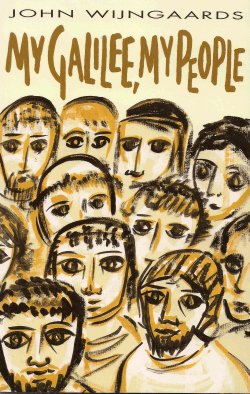 When Jesus was baptised by John the Baptist, he received a vision from
his Father.(1) He knew that the Father was now sending him to call people to
repentance and to preach his kingdom of love. How was he to achieve this
difficult task?
When Jesus was baptised by John the Baptist, he received a vision from
his Father.(1) He knew that the Father was now sending him to call people to
repentance and to preach his kingdom of love. How was he to achieve this
difficult task?
Jesus needed time to think. That is why he went into the desert. He made a retreat of forty days to prepare himself. What was his approach to be like? Should he present himself as a general or a politician? The temptation story tells us the outcome of his prayerful reflection. He realised that his Father did not want him to rely on the secular means of money, power and fame.(2) God's kingdom of love can only be spread by love ....
On the other hand, Jesus also knew that he had to be practical; that he needed to use his common sense. Later we hear him tell his apostles to be simple as doves, yet clever as snakes. And he also believed in planning: a man building a tower should get his sums right first; a king should plan his strategy before going to war. (5)Jesus recognised that he could not change the world on his own. He needed to find allies - and the right place to work from ....
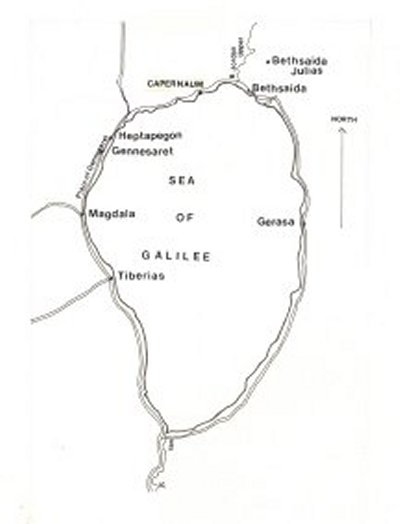
The sixth-century writer Theodosius describes the traditional places for Christian pilgrims:
'From Tiberias to Magdala, where the Lady Mary was born, two miles.
From Magdala to Seven Fountains ( = Ayn Tabgha),
where the Lord Christ baptised the apostles, is two miles.
There he also fed the crowd with five loaves and two fishes.
From Seven Fountains to Capernaum two miles.
From Capernaum to Bethsaida, where the Apostles Peter, Andrew,
Philip and the sons of Zebedee were born, two miles.(4)
We have already seen that Galilee consisted roughly of two areas: the hill country and the plains. To reach out to the whole province, he needed to put his centre in the plains; preferably in the pivotal plain north of the lake. There everything came together: government, trade, religious leadership. From there, like spokes from a hub, roads ran to the valleys and hills, and even to the neighbouring provinces. There, too, he would find the people who could help him in his work.
Tiberias, west of the lake, was the actual capital. Herod Antipas resided there. Much of Galilee's wealth and political power was concentrated in that city. But Jesus rejected it as a centre for his ministry. The reasons are not difficult to understand. Tiberias had been built by Herod Antipas in 13 AD as a totally Greek city. It possessed a stadium for horse races, public baths for the rich, a luxurious palace and a hall for the city council.
Even though Jews too lived there, it was considered a monument of foreign imposition. Herod, himself an Idumean, dedicated the city to the Roman Emperor, Tiberius. Moreover, overriding Jewish sensitivities he had built the centre of the city on an old cemetery, thus desecrating the tombs and making the whole city 'unclean'. Flavius Josephus, a historian of Jesus' time, tells us that ordinary Galileans 'hated Tiberias'.(6) Neither this city, nor the adjoining pleasure town, Magdala, were acceptable to the ordinary people.
Jesus, therefore, turned to the north of the lake. There lay a typically Jewish town, Capernaum.
Capernaum enjoyed a privileged position. One road ran along the shore from east to west, linking Phoenicia and Galilee with the regions across the Jordan. Another major road, the imperial highway, ran from the south, skirted around Capernaum and bent to Damascus in the north. In 1975 a milestone was found close to Capernaum with this inscription: '(Erected by) the Emperor, Traianus Adrianus Augustus, son of the divine Traianus Parthicus, nephew of the divine Nerva'. Coins found in Capernaum confirm its commercial links with many countries: Golan, Syria, Phoenicia, Asia Minor and Cyprus.
The Gospel mentions that Capernaum possessed a customs house, the one in which Levi, son of Alphaeus, worked as a commercial inspector.(7) The duties were collected here because Capernaum was a border town through which people entered the tetrarchy of Herod Antipas. The presence of a detachment of Roman soldiers in the town also underscores its strategic importance.(8)
Capernaum would be an excellent choice. It would give Jesus a presence in the heartland of Galilean public life. It would provide easy access to the surrounding regions ....
Matthew tells us:
'Jesus left Nazareth and settled in Capernaum,
in the land of Zebulun and Naphtali.' Matthew 4,13
Capernaum became Jesus' residence.
'Jesus got into the boat and went across the lake to his own town.' Matthew 9,1
'Jesus went to Capernaum and the news spread that he was at home.' Mark 2,1
What about Capernaum itself? What kind of place was it? Can we visualise what it looked like? And how did Jesus go about building up new relationships?
During the last century scholars debated the exact location of Capernaum. (9) Excavations and a renewed study of ancient literary sources allow us now to pinpoint the place exactly.
The town itself was not very big. Not more than 1000 people lived in it. But a large strip of land outside the town proper belonged to it: from the Jordan on the east to the spring of Ayn Tabgha on the west. Both the town and the land belonging to it, were often referred to by the same name.(10)
Flavius Josephus, who was governor of Galilee some forty years after Jesus' death, talks about the town in these terms:
'During the battle (at the mouth of the Jordan, north of lake Galilee) the horse I rode sank in boggy ground and threw me off. I was taken to the village Capharnomon with a bruised wrist.' (11)
He also mentions its land, and the spring Ayn Tabgha that waters the plain of Gennesaret:
'Apart from the lovely, warm climate, it is watered from a most fertilising spring. The local people call it Caphamaum. Some maintain the water of the spring could come from the Nile because it produces as much Coracin fish as the lake near Alexandria.’ (12)
The spring (present-day Ayn Tabgha) was an outpost of Capernaum, a small 'industrial suburb'. That is why it, too, car- ried the name of Capernaum. Excavations have shown that there were mills; and other industries, such as potteries and tanneries. Water from the spring irrigated not only Capernaum's coastal strip, but, via a cemented channel cut through Capernaum the rock, it also irrigated the nearby plain of Gennesaret. (13)
Jesus, however, settled in the main village, in the town of Capernaum itself. Recent excavations (1968 - 1984) have uncovered about half of the ancient site. My attempt at a reconstruction of the town will closely follow the latest archeological reports. (14)
The town Capernaum covered only a few acres. We do not know its precise size at the time of Christ. Probably it was not more than 200 yards deep (from north to south, i.e. from the lake to the hills) and 300 yards wide along the shore of the lake (see the plan of part of the excavations).
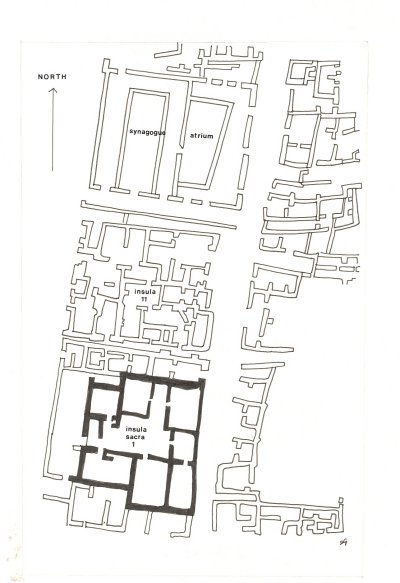
Although remains of very early human occupation have been found underneath some houses, the town of Jesus' time had been founded in the 5th century BC. This means that it may well have begun as a small Persian settlement, established to control the trade routes along the northern shore of the lake. In the course of time Jews settled in the town, as petty officials, traders, skilled labourers and so on, forming, in the end, the majority of its population. Under successive Greek and Roman colonial rulers Capernaum may have retained its character of a local government post.
This official character can still be seen in its systematic town plan. As in other Persian/Greek/Roman cities, there are main streets (here running from north to south) intersected by small alleys (that run from east to west). The result is a number of square blocks of houses.
The excavations revealed two places of special interest: a synagogue and a Christian shrine to mark St.Peter's house. Since both these places are of great concern to us, we will pay special attention to them later. The question we should consider first is: can we say anything more definite about the kind of people who lived in Capernaum in Jesus' time?
We can. One striking observation is that we do not find the great social contrasts that existed in other parts of Galilee. Almost all the houses have a similar design. We do not come across huge mansions next to tiny hovels. The citizens of Capernaum were middle-class people. Their houses were simple, but not poor by the standards of the time.
This confirms Capernaum's role as a government post and a trading centre. There were local industries too. Finished and unfinished olive presses have come to light, grinding stones for use in the homes, mortars, bowls and craters. This equipment, made of basalt stone, was manufactured in Capernaum itself. A workshop to produce glass vessels has also been unearthed. The fishing industry, too, was not as primitive as we sometimes imagine. Fish was transported to Tarichaeae (near Magdala) where it was dried and salted for export.
Of course, the town must have had its share of outcasts and underdogs; like the leper whom Jesus cured just outside the town (16) and the Roman officer's slave. (17) But on the whole the citizens of Capernaum were free citizens and skilled workers, ordinary people who had to work hard to make ends meet.
These were the people Jesus chose to become his close associates. How did he make his first friends among them? It is a story the Gospels and modern archaeology allow us to reconstruct with some precision.
It is likely that Jesus hired a room somewhere in or near Capernaum. On account of its position along a number of major roads, Capernaum must have had some inn or guest house for travellers to stay. The Gospel of John has preserved some traditions about these earliest days. John the Baptist was baptising near Bethany, on the east side of the river Jordan. That may well have been on the banks of the Jordan north of the lake of Galilee. That would explain why fishermen from Capernaum and Bethsaida were the Baptist's disciples at the time.
John the Baptist told his followers he had seen the Spirit come down on Jesus.(18) Impressed by this testimony, two of John's audience walked up behind Jesus, desirous to meet him.
Jesus turned round and saw they were following him.
'What are you looking for?' he asked.
They answered: 'Where do you live, Teacher?'
'Come and see', Jesus replied.
It was about four o'clock in the afternoon. They walked along with him, saw where he lived and spent the rest of the day with him.' John 1,37-39
The Gospel then tells us that one of these two first disciples was Andrew. Andrew took his brother, Simon, to meet Jesus. Jesus gave him the new name Cephas (in Aramaic) or Peter (in Greek), i.e. 'Rock'. (19) Peter and Andrew were fishermen. Jesus invited them to leave their fishing nets and join him as 'fishermen of people'. (20) It must have been a time of an intense common search. Jesus explained his vision and obtained the first personal commitments.
All the evidence we have now points to a new development: Peter invited Jesus to stay in his house. Leaving his temporary place in the travellers' lodge, Jesus moved into a room in Peter's house. As we know from the excavations in Capernaum and elsewhere, an ordinary 'house' consisted of a number of rooms clustered round a courtyard. Each room would accommodate a family. Relatives would tend to join together. This gave more security: there was a common entrance to the courtyard and cooking facilities in the yard were shared.
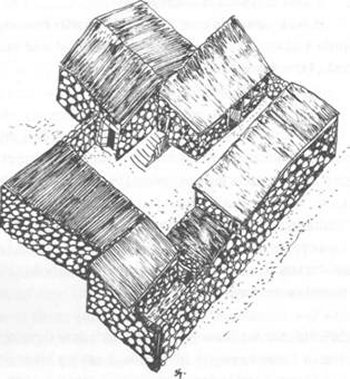
Plan of the courtyard underlying 'Peter's shrine'.
No 1. The special room that became the centre of the shrine. Was this where Jesus stayed?
No 2 - 6. Other living rooms. Here the families of Peter and Andrew may have lived.
Pilgrims to Palestine in the early centuries are known to have visited a place in Capernaum which they believed was 'Peter's house', 'the house where Jesus lived'. Archaeology has now found that house. As is common with ancient shrines, in the course of the centuries ever more elaborate monuments were built on top of one another (see the historical survey below). The great interest for us is that it gives us quite an accurate i picture of what the house was like in Jesus' time. (21)
One entered St.Peter's house, if we may call it such for a moment, through a gate from the main north-south street (see plan on opposite page). Inside was an L-shaped courtyard. It gave access to six rooms, of which the one immediately left of the gate was the special room, the room later venerated as a shrine. This was, perhaps, Jesus' own room. The courtyard had grinding stones and a fireplace, and a flight of stone stairs leading up to its roof. All the rooms could only be entered from the courtyard.
On the whole the rooms were rather narrow and dark. The walls were built up from rough basalt stones placed upon each other, poorly cemented together with a mixture of mud and pebbles. The walls were weak and could not be drawn up higher than nine feet. The rooms received light from small windows that looked out onto the courtyard. The roofs consisted of wooden beams covered by a plaster of beaten earth mixed with straw. In some cases, when the roof was used for space to sit on or to support a second floor, the beams were stronger and covered with flat tiles.
|
History of Peter's house as a shrine based on archaeological excavations 1. The central, oldest room dates from the first century AD. It was part of the usual type of 'courtyard house'. From the end of the first century it was used for prayers and religious meetings. Rabbinical sources confirm that there was a Christian Jewish community at Capernaum at the time. The room must have been a sacred shrine for them.2. In the fourth century Greek pilgrims built a sanctuary on the same spot. A large enclosure wall was constructed around the central, oldest room. The room was redecorated with frescoes of geo- metrical figures, flowers, branches, trees and so on. More than 150 inscriptions were found on the walls, calling on Jesus as the Lord. The pilgrim Etheria (385 AD) described the sanctuary in these words: 'In Capernaum the house of the prince of the apos- tles (St.Peter) has been made into a church. Its walls still stand today as they were'. 3. Byzantine Christians built an octagonal Church over it in the fifth century. A pilgrim from Piacenza visited it in 570 AD :'We arrived at Capernaum in Blessed Peter's house. At present it is a basilica'. It was probably destroyed by the Persians in 614 AD and remained a ruin ever since. Since the tradition is so old, it is very likely that this room was remembered as the place (in Peter's house) where Jesus stayed. |
It is here that various incidents related in the Gospels come to life.
Leaving the synagogue, Jesus went, with James and John, straight to the house of Peter and Andrew. Simon's mother-in- law was sick in bed with a fever. They informed Jesus about this immediately. He went to her, took her by the hand and helped her up. The fever left her and she began to wait on them.
That evening, after sunset, people brought to Jesus all the sick and those possessed by demons. The whole town crowded round the door. He healed many who were suffering from all kinds of diseases. Mark 1,29-34
After one of his missionary tours, Jesus came back to Capernaum. 'The news spread that he was at home.' Many people came to see him. He talked to them in his house. Four men arrived, who must have been from a neighbouring village. They were carrying a paralysed relative on a mat. Because of the crowd they could not get near to Jesus. So they climbed up the stairs leading to the roof. 'Then they made a hole in the roof right above the place where Jesus was. Through the opening they let the man down, lying on his mat.' Jesus was impressed by their faith. He talked to the paralysed man, forgave him his sins and cured him. Read Mark 2,1-12.
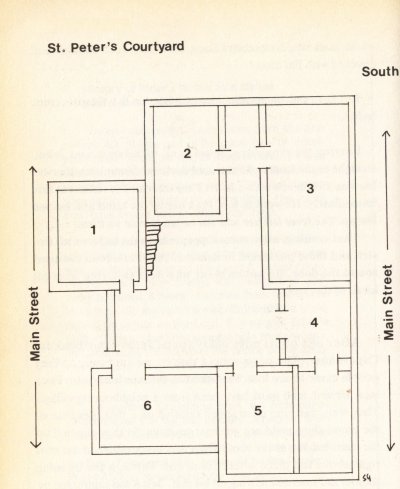
Reconstruction of Peter's courtyard.
The room at the left hand top may have been the room where Jesus stayed.
It became the centre of the later shrine.
Practically all the houses in Capernaum must have looked like this.
Again, another time, when Jesus returned with his apostles, he taught them privately a lesson in the seclusion of his own home. 'They came to Capernaum'. After going indoors he asked his disciples: 'What were you arguing about on the road?' They did not give any reply, but he knew they had been quarrelling about who among them held the highest rank. So Jesus sat down, made a child stand in their middle and told them: 'Whoever wants to be first, must become like a child.' He embraced the child and blessed it. Read Mark 9,33-37.
The collectors of the Temple tax came to Capernaum, we are told. They asked Peter: 'Will your master not pay the tax?' 'Of course, he will', Peter replied. He entered the house, probably intending to pay for Jesus. But Jesus knew what had happened. He told Peter that strictly speaking he was exempt from the tax; but that, in order to avoid difficulties, it would be better to pay the tax from the day's catch of fish. (22) Read Matthew 17,24-27.
Having moved in with Peter, Jesus soon became a local resident of Capernaum. By intense, everyday sharing of life he could create the deep, personal relationships that formed the beginning of the Church. From his new home his message spread to ever wider circles.
From what the Gospels tell us, we know that Capernaum possessed a synagogue and that Jesus regularly took part in its services.
Jesus and the apostles came to Capernaum.
As soon as it was Sabbath, Jesus went to the synagogue and began to teach. Mark 1,21.
He taught this doctrine at Capernaum, in the synagogue there. John 6,71
Synagogues are prayer halls where Jews meet on the Sabbath day to pray and to listen to readings from the Bible. (23) In Jesus' days synagogues already portrayed all the essential features we know today. They were simple, rectangular structures, with benches around the sides, and a pulpit. In an alcove that could be curtained off, an 'ark' was kept that held the Bible scrolls.
Among the ruins of Capernaum, under a building of a later date, the synagogue of Jesus' time has been rediscovered (see the survey of its history below). We can be quite sure that this was the place Jesus knew. The Gospels always speak of the synagogue and no similar structure was found elsewhere among the ruins. (24)
| History of Capernaum's Synagogue based on
archaeological excavations 1. The oldest part are houses from the early Hellenistic era (third and second century BC). 2. In the first century AD a simple rectangular synagogue was constructed. Of this, the floor, made of basalt stones, and the lower part of some walls still remain. 3. In the fourth century a larger, and more beautiful, synagogue was constructed over the earlier one. Heavy, well-carved, limestone blocks were used for the walls and the facade. Its columns and lintels were decorated with elaborate stone carvings. Many coins were found in a treasury belong- ing to this time. The pilgrim Etheria (385 AD) was impressed. 'One enters the synagogue by many steps. It has been built from square stones'. Some Jewish historians think the Emperor Julian the Apostate (361-363 AD) paid for its construction. He tried to suppress Christianity among other ways by encouraging Judaism. (25) 4. In the fifth century additional rooms were added to the building. 5. Like St.Peter's shrine, the whole edifice was probably destroyed by the Persians in their campaign of 614 AD. |
Basing ourselves on the archaeological evidence, we can visualise what the synagogue looked like. It was a longish hall, 18 meters (54 feet) long and 8 meters (24 feet) wide. It could accommodate from 70 to 100 people. The Torah may have been read from the southern wall, so that the congregation faced in the direction of Jerusalem. Probably the synagogue had one main entrance and small windows along the walls. Both the door and the shutters for the windows were made of wood.
When Jesus took part in the services, he may have been invited to do a reading and provide commentary. This would give him an opportunity to preach the Good News. Also after the services, if the synagogue was left open, Jesus could continue to speak to whoever wanted to listen to him.
Jesus taught with authority and not like the scribes, the Gospels tell us. That is why he made a deep impression on people in Capernaum.(26) He also performed miracles in this synagogue, such as the healing of a man possessed by an unclean spirit. (27) Through such activity Jesus must have steadily widened the circle of his followers. Reports of what Jesus did 'spread throughout the region'. (28)
The Roman officer who was stationed in Capernaum wanted Jesus to cure his slave. The man was seriously ill. Instead of approaching Jesus directly, he sent some of the Jewish elders to plead on his behalf. The elders mention an interesting fact. 'This Roman deserves a favour', they said to Jesus. 'He is friendly towards our people. He is the one who built the synagogue'. (29)
What exactly did the officer do? Did he put up money for the building? Did he help by granting the necessary permissions? Or did he order his soldiers to execute the construction work? After all, soldiers were taught to build fortifications, and spanning the prayer hall with wide enough wooden girders must have required special skills. It is an interesting example of Roman-Jewish cooperation. It also shows that the synagogue was a recent acquisition for the town.
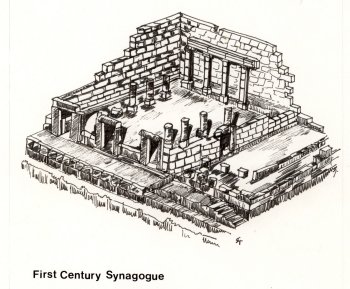
From the excavations in Capernaum and elsewhere, we know that synagogues in Jesus' time had a simple plan. After entering one of the doors, one saw a central nave surrounded by colonnades. The three side aisles contained benches for seating the worshippers.
It was in this synagogue in Capernaum that Jesus argued with the people about his own role. (30) Many were not prepared to believe that he was the new 'bread that comes down from heaven'. 'This teaching is too hard .... Who can listen to it?' A large number of people turned away from Jesus. (31) The lines of division were beginning to be drawn.
Jesus' demand for conversion and for the acceptance of new standards in the kingdom of his Father, pleased some people and displeased others. The case of the repentant tax collector illustrates the point.
Levi, son of Alphaeus, was an inspector of custom duties, attached to the tax house along the road near Capernaum. At Jesus' words 'Follow me!', he left his job and became one of Jesus' disciples. Many of the orthodox Jews were scandalised. When Levi organised a meal for Jesus in his home, they complained: 'See, he eats with criminals and tax collectors!' (32)
Jairus, one of the men in charge of the synagogue, asked Jesus to come to his home and heal his little daughter. When they arrived at the house, they found mourning had begun because the girl had died. Jesus said she was asleep. They laughed and mocked him. Jesus had to turn them out of the room before he could cure the girl. (33)
Capernaum was the town where Jesus recruited his first band of supporters. It was also the centre of the first core of opposition. The bustling, hard-working, flourishing town at the north end of the lake had its fair share of pride and inflexibility.
After complaining about the neighbouring towns, Chorazin and Bethsaida, Jesus also warned Capernaum.
'And what about you, Capernaum?
Will you be exalted to heaven?
You will be thrown down to hell!
If the miracles performed in you had been done in Sodom, it would still stand today!
I tell you, on judgment day God will have more mercy with Sodom than with you!' Matthew 11,23-24
They were the prophetic words of a man concerned about people he had come to consider his own.
1. Jesus chose Capernaum as the centre for his public ministry.
'Jesus left Nazareth and took residence in Capernaum, in the land of Zebulun and Naphtali . . . Matthew 4,13.
Why did Jesus not 'think big'? Like establishing himself in Tiberias (the capital of Galilee), Jerusalem (the capital for all Jews) or Rome (the capital of the Roman Empire)?
2. Jesus often received people in his home.
'Where do you live teacher?' they said.
'Come and see', Jesus replied ....
They saw where he lived and spent the rest of the day with him. John 1,38-39
What can we learn from Jesus' pastoral practice?
3. Right from the beginning Jesus encouraged others to join him in his mission. Comment on Jesus' strategy in the light of this text from Vatican II:
When people work, they do not only change things and society, they develop themselves as well. They learn much, cultivate their resources, go outside themselves and beyond themselves.
Rightly understood this kind of growth is of greater value than any external achievement. People are more precious for what they are than for what they have. The Church in the Modern World, no 35.
1. Matthew 3,13-17.
2. Matthew 4,1-11; about the meaning of the temptation story, see J.WIJNGAARDS, Jesus for Ever, London 1988, pp. 60 - 64.
3. Matthew 10,16.
4. Itinerarium Hierosolymitanum, Vienna 1898, pp. 137-138. The Roman mile was 1.48 km. The distances are not correct.
5. Luke 14,28-33.
6. FLAVIUS JOSEPHUS, Life, no 381 - 389; on Tiberias, see S.FREYNE, Galilee from Alexander the Great to Hadrian, Wilmington 1980, pp. 129 - 134.
7. Mark 2,13-14.
8. Matthew 8,5-13; Luke 7,1-10.
9. See, for example, W.SANDAY who reviews the arguments at the time in Sacred Sites of the Gospels, Oxford 1903, pp.36 - 48.
10. W.SANDAY, 'The site of Capernaum', Journal of Theological Studies 5 (1904) pp. 42 - 48.
11.'Capharnomon' is a Greek variant of the name; FLAVIUS JOSEPHUS, Life, c.72, no 403.
12.. FLAVIUS JOSEPHUS, Jewish Wars, III, 10, 8; no 519, 520.
13. C.KOPP, Die heiligen Stätten der Evangelien, Regensburg 1959, pp. 215 - 220; The Holy Places of the Gospels, London 1964, pp. 171 -177.
14. B.BAGATTI, 'Caphernaum, la ville de Pierre', La Monde de la Bible 27 (1983) pp. 8 - 16; V.TZAFERIS, 'New Archaeological Evidence on Ancient Capernaum' Biblical Archaeologist 48 (1985) pp. 207 - 216; S.LOFFREDA, Capharnaum. The Town of Jesus, Jerusalem 1984; Recovering Capharnaum, Jerusalem 1985., Jerusalem 1985.
| 15. Matthew 8,1-4; Mark 1,40-45. | 16. Matthew 8,5-13; Luke 7,1-10. |
| 17. John 1,28. | 18. John 1,29-34. | 19. John 1,40-42. |
20. Mark 1,16-18; Matthew 4,18-20; Luke 5,1-11.
21. Even if it were not to be the actual place where Jesus lived (though its credentials are excellent!), it helps us visualise what Jesus' residence was like. All houses in Capharnaum are similar in type.
22. The sign of the tax coin found in the fish's mouth will be explained in the WALKING ON WATER book the Resurrection.
23. More information about this in the WALKING ON WATER course Religion of the heart.
24. 2. J.STRANGE and H.SHARKS, 'Synagogue where Jesus preached found at Capernaum', The Bulletin of Archaeological Research 9 (1983) pp. 24 - 31.
25. W.ZANGER,' A visit to the Kinneret', Bible Times 1 (1988) pp. 74-81.
| 26. Mark 1,22; Luke 4,31-32. | 27. Mark 1,28; Luke 4, 33-36. |
| 28. Luke 4,37. | 29. Luke 7,1-10. | 30. John 6,25-59. | 31. John 6,60.66. |
32. Mark 2,13-17; Luke 5,27-32; in Matthew 9,9-13 he is called Matthew.
33. 1. Mark 5,21-23.35-43; Matthew 9,18-19.23-26.